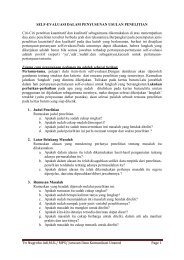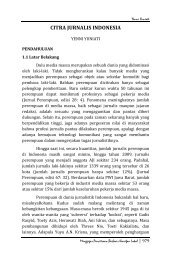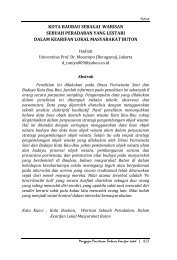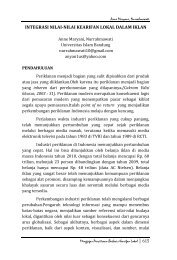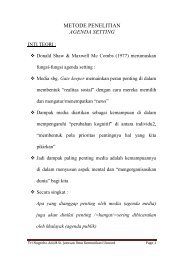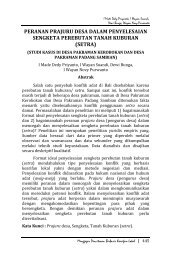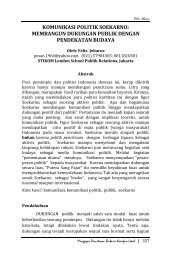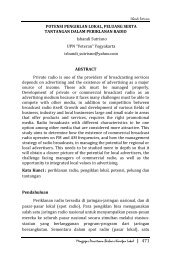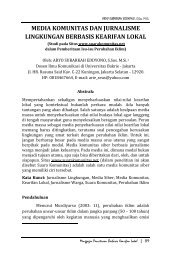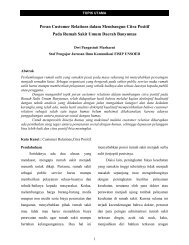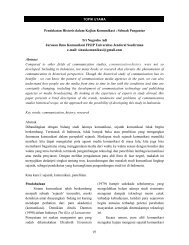New Vocabularies in Film Semiotics
New Vocabularies in Film Semiotics
New Vocabularies in Film Semiotics
Create successful ePaper yourself
Turn your PDF publications into a flip-book with our unique Google optimized e-Paper software.
66 CINE-SEMIOLOGY<br />
sequence of Strangers on a Tra<strong>in</strong> (1951), as a number of commentators<br />
have po<strong>in</strong>ted out, orchestrates an elaborate verbal and visual play on the<br />
expressions “crisscross” and “double-cross” (crossed railroad tracks,<br />
crossed legs, crossed tennis racquets, tennis doubles, double scotches,<br />
alternat<strong>in</strong>g montage as double, lap-dissolve as a criss-cross of images and<br />
so forth). Hitchcock’s cameo appearance, significantly, shows him carry<strong>in</strong>g<br />
a double bass, <strong>in</strong> a film featur<strong>in</strong>g two doppelganger characters each, <strong>in</strong> his<br />
way, “base.”<br />
Language, at least potentially, exerts pressure on all the filmic tracks.<br />
The music and noise tracks, for example, can embrace l<strong>in</strong>guistic elements.<br />
Recorded music is often accompanied by lyrics, and even when not so<br />
accompanied, can evoke lyrics. The purely <strong>in</strong>strumental version of<br />
“Melancholy Baby” <strong>in</strong> Lang’s Scarlet Street (1945) elicits <strong>in</strong> the spectator<br />
the mental presence of the words of that song. Even apart from lyrics, the<br />
allegedly abstract art of music is permeated with semantic values.<br />
Musicologist J.J.Nattiez (1975), for example, sees music as embedded <strong>in</strong><br />
social discourses, <strong>in</strong>clud<strong>in</strong>g verbal discourses. Nor are recorded noises<br />
necessarily “<strong>in</strong>nocent” of language. Sett<strong>in</strong>g aside the question of the<br />
cultural relativity of the boundaries separat<strong>in</strong>g noise from music from<br />
language—one culture’s “noise” may be another culture’s “language,” as <strong>in</strong><br />
the case of African talk<strong>in</strong>g drums—we discover the frequent imbrication of<br />
noise and language <strong>in</strong> countless films. The stylized murmur of convers<strong>in</strong>g<br />
voices <strong>in</strong> classical Hollywood restaurant sequences renders human speech as<br />
background noise, while Jacques Tati films give voice to an <strong>in</strong>ternational<br />
esperanto of aural effects—vacuum cleaners that wheeze and v<strong>in</strong>yl seats<br />
that go “pooof”—characteristic of the postmodernist environment. 4<br />
Even when verbal language is absent from both film and movie theater,<br />
semantic processes take place <strong>in</strong> the m<strong>in</strong>d of the spectator through what<br />
the Russian Formalists called “INNER SPEECH,” the pulse of thought<br />
implicated <strong>in</strong> language. <strong>Film</strong> view<strong>in</strong>g, accord<strong>in</strong>g to Boris Eikhenbaum, is<br />
accompanied by a constant process of <strong>in</strong>ternal speech, whereby images and<br />
sounds are projected onto a k<strong>in</strong>d of verbal screen which functions as a<br />
constant ground for mean<strong>in</strong>g, and the “glue” between shots and sequences.<br />
In the 1970s and 1980s, the journal Screen published a series of essays both<br />
by and about Eikhenbaum’s theories of <strong>in</strong>ner speech. Paul Willemen<br />
(Screen 15, W<strong>in</strong>ter 1974–5) saw the notion of <strong>in</strong>ner speech as potentially<br />
fill<strong>in</strong>g a gap <strong>in</strong> Metz’ theories by demonstrat<strong>in</strong>g the l<strong>in</strong>guistic nature of<br />
mean<strong>in</strong>g and consciousness, as well as the l<strong>in</strong>k to psychoanalysis, s<strong>in</strong>ce the<br />
condensations and distortions of <strong>in</strong>ner speech were closely ak<strong>in</strong> to the<br />
mechanisms explored by psychoanalysis. Willemen went on to evoke the<br />
possibility of a specifically c<strong>in</strong>ematic k<strong>in</strong>d of <strong>in</strong>ner speech essential to the<br />
construction and understand<strong>in</strong>g of films. S<strong>in</strong>ce this <strong>in</strong>ner speech is<br />
language-specific, the filmic images are often grounded <strong>in</strong> the tropes of<br />
specific languages. Much of the discussion <strong>in</strong> the 1970s centered on the



